Pre-cast panels and other options can elevate this underestimated material from aesthetically stolid to striking. Here’s what you need to know to do it right.
By Robert Stroup, AIA, NCARB, LEED AP, WELL AP, CSI, CDT
When establishing the groundwork for impressionism, Claude Monet famously said “my garden is my most beautiful masterpiece.” Monet recognized that humans are drawn to what is naturally cultivated. In the architectural study of wellness, this relationship to the healing power of nature is known as biophilia.
As architects, we often aspire to design interior spaces that feel almost organic, born from necessity. The same should be true for the exteriors, as well. The cladding of a building can achieve some of the same biophilic appeal.
The genius loci (the pervading “spirit of place”) should not be lost when building in any environment. To achieve harmonious integration into the broader landscape, architects and owners often seek cladding materials that are functional and regional. Here in the Midwest, this typically means the use of brick, metal, concrete, or wood. Brick and metal are safe bets because of established standards laid out by manufacturers. The use of wood is less common; limited to fire retardant treated lumber for healthcare occupancies, it is rarely employed as cladding for larger scale projects. Concrete is mostly misunderstood as a cladding material, and that’s a shame because it offers real possibilities.
Throughout the 20th century, reinforced concrete was generally seen as utilitarian “man-made rock” and employed mainly for structural integrity in parking garages, foundations, and elevated building construction. Yet the aesthetic potential of concrete has largely been missed in commercial construction until recently. Owners looking to distinguish their brands with exterior cladding should consider the possibilities of concrete beyond typical assumptions about the material.
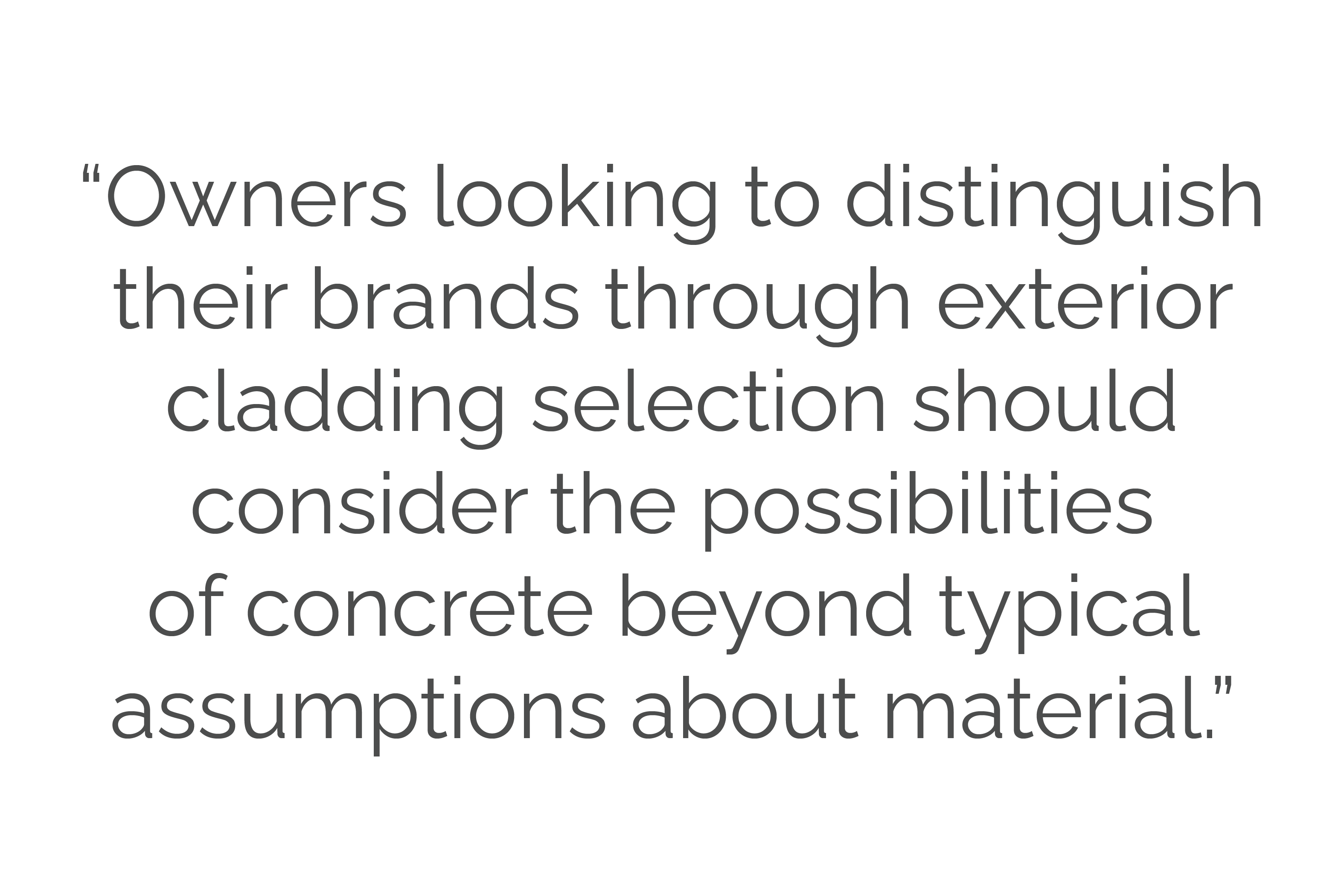
More Than Pure Function — Indoors and Out
Concrete has a unique duality: while functional for weatherproofing and support, it also offers a natural aesthetic with comparable prices to interior and exterior products. Though it’s often concealed, concrete that’s architecturally exposed can create highly refined, minimalist interior spaces. When properly executed, poured concrete countertops and millwork offer endless possibilities. With advances in formwork and construction techniques, architecturally exposed concrete can also bring a humble aesthetic to building facades and reduce the need for additional trades.
Two methods are typically employed to achieve a heightened level of design with exterior concrete: pre-cast and cast-in-place construction. Pre-cast concrete panels, which are molded and then cured in a controlled environment, are durable, clean, noncombustible and can be unitized, eliminating the need for onsite formwork. Panels can be designed as either structural tilt-up walls or as cladding. Cast-in-place concrete, conversely, is constructed on site and is mostly structural in nature; this form of construction has advantages where strength and higher levels or insulation are required.
It’s important to engage a construction manager who understands the nuances of the material. The workforce, unfortunately, has limited tradesmen with the necessary expertise, so it is vital for architects to provide insights as early in preconstruction phases of design as possible while setting reasonable benchmarks for the material. Providing intuitive performance specifications can better address appropriate concrete mixes, aggregates, and enhanced sustainability targets while achieving the envisioned form.
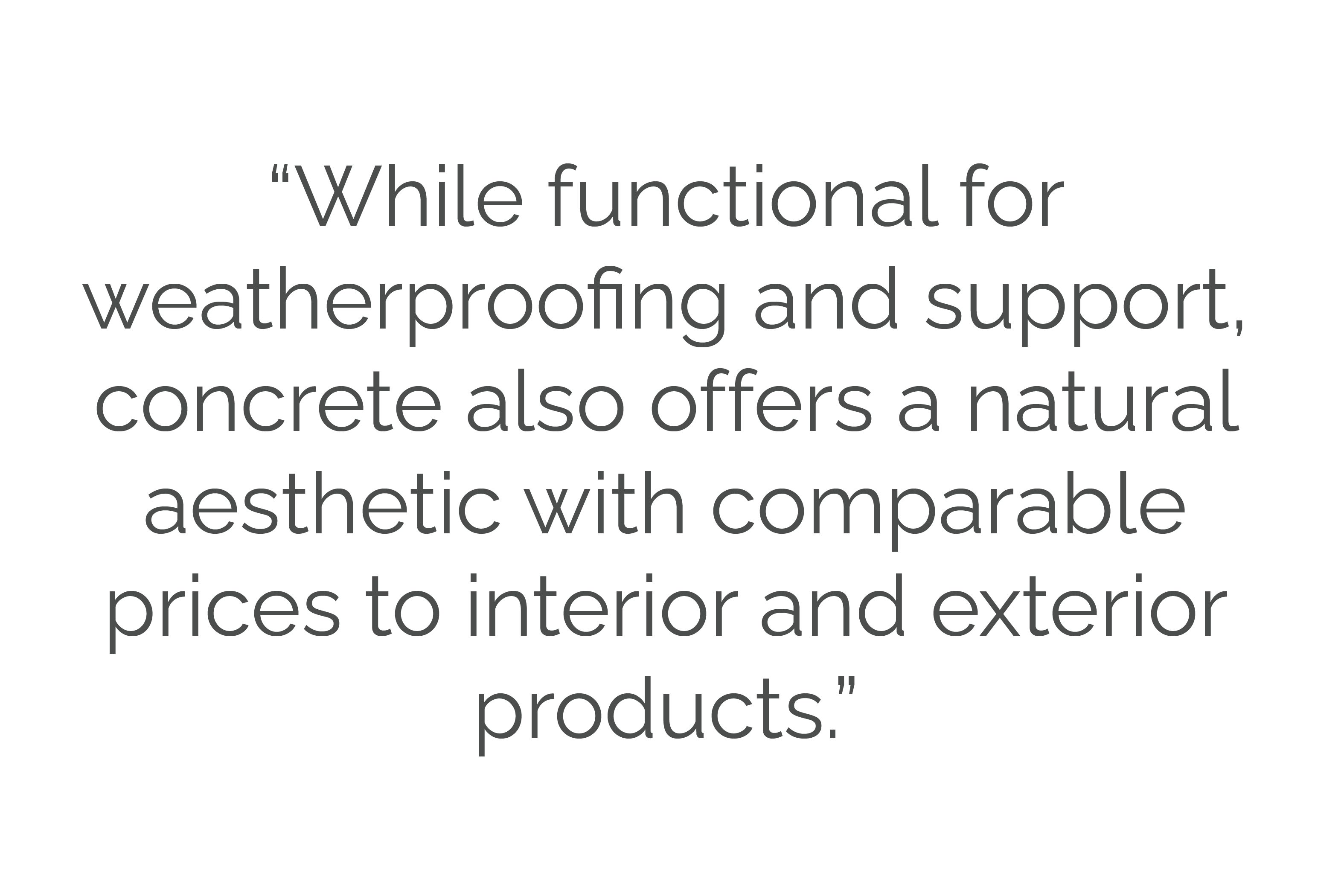
Architectural considerations for formed concrete include:
- Method of construction (concrete is built twice, once as formwork/mold and once as concrete)
- Construction and site-related logistics
- Color and texture of concrete
- Treatment of joint locations
- Chemical composition of concrete
Most critically, if cast-in-place, the formwork itself should be well understood by the contractor. Architects have multiple design choices: using the form itself to imprint into the concrete or casting it through the removal of the cement paste skin. These options are more commonly known as board-formed concrete and exposed aggregate concrete. A third option in precast panels presents itself when more versatility, quality-control and time-efficiency is sought on a project.
Board-Formed Concrete
Board-forming concrete is a cast-in-place process of imprinting that leaves a wood grain pattern on the finished face of concrete. It can visually soften and warm concrete’s somewhat cooler appearance while still allowing concrete to express construction technique. Prior to casting, formwork is built on site to hold wet concrete in place until it hardens. A layer of selected wood is added to the inside face of the plywood formwork, which allows the cast concrete to take on the pattern of wood’s surface. The wet concrete will take on the grain structure of the dimensional lumber. The contractor responsible for pouring should keep dendrochronology in mind; the difference between winter and summer tree rings will show in the patterning on board-formed concrete.

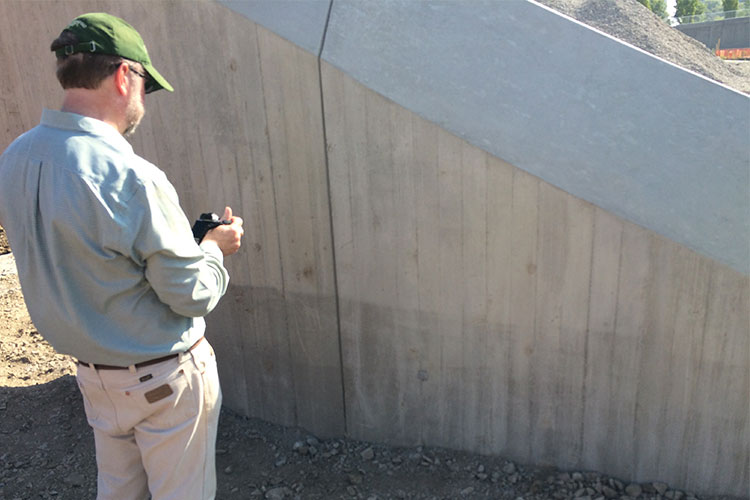
In DesignGroup’s collaboration with Allied Works Architecture on the National Veterans’ Memorial and Museum in Franklinton, Ohio, during the construction administration phase, two wood-imprint options were explored: a board-formed finish or a smooth as-cast finish (in which form liners are placed on plywood to secure a sought texture). For the board-formed finish, a narrow 4” width for boards was specified. Reveal lines, tie holes, and joints were located per architectural drawings and approved in shop drawings. For the smooth as-cast finish, joints were spaced to reflect the actual panels of plywood, which were sloped to address the required exterior wall curvature. Form material was specified as either MDO, HDO or phenolic surface film plywood. In both forming techniques, a uniform high quality of finish was sought to obtain a consistent surface texture, color, and porosity. Boards were tightly connected, and precautions were employed to stop grout loss between boards. Most importantly, objectives were clearly stated to meet concrete surface category CSC4 as defined in ACI 347.3R-13, meeting industry-wide standard expectations for exposed concrete in museum construction. Ultimately, after reviewing mockups, the smooth as-cast finish was chosen as it proved more capable of addressing overall design needs while addressing the project’s budgetary and scheduling parameters.
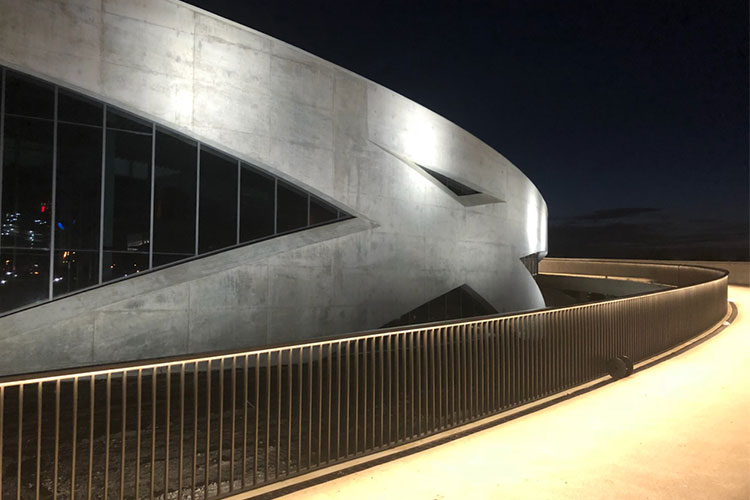
This is a caveat to board-forming: if a project is not rectilinear in design or has a highly irregular exterior surface, a smooth as-cast finish may prove a more economical and effective option. While the cost to detail varies by region, on average the process of board-formed concrete is around $30 to $50 per square foot. In addition to the cost of the concrete there will also be the expense of securing wood, ripping it in half, sandblasting the surface to enhance texture, and then applying it to the interior faces of the plywood formwork.
Exposed-Aggregate Concrete
Exposing aggregate is another method to enhance concrete’s visual appeal. This technique is akin to polishing marble or granite; an unremarkable skin is stripped away to expose the underlying beauty of the utilitarian material. This beauty comes in the form of a decorative aggregate.
This process has been around since the early 1900s, before stenciling, stamping and overlays became popular. Because of its innate durability and traction, exposed aggregate concrete can be used for sidewalks, driveways, patios, plazas, and other walking surfaces. It can also be used where rougher appearances are desired, such as in retaining walls or building facades, and can be a feature of either pre-cast or cast-in-place construction. It is also typically used in conjunction with regularly placed concrete to achieve a desired aesthetic, and little maintenance is required other than sealing and periodic cleaning.
Pre-Cast Panels
With an old-world meets new-world appeal, pre-cast concrete panels can elevate both classical and contemporary designs. Offering a wide variety of finishes and sizes, pre-cast construction offers the client a traditional aesthetic that is best employed either throughout a façade or at the lower levels of a building.
Typical rules of thumb for precast construction:
- Textured surfaces provide more uniformity than smooth surfaces due to the natural variations in aggregates
- The maximum height of loads is typically around 13’ 6” (including trailer and shipping frame height)
- The maximum width without permit is roughly 8’ 6” and the maximum load without permit is 48,000 lbs
- Ensure proper crane access and swing space from truck to building placement
- In general, work to avoid precast placement under soffits
At the Columbus Spanish Immersion K-8 School, DesignGroup worked with Integrated Precast Solutions in the design of a precast sandwich panel exterior that provided a durable exterior with peak thermal performance. Panels were 12” thick overall, with a 3” thick exterior panel and 6” interior panel sandwiching a 3” rigid insulation panel.
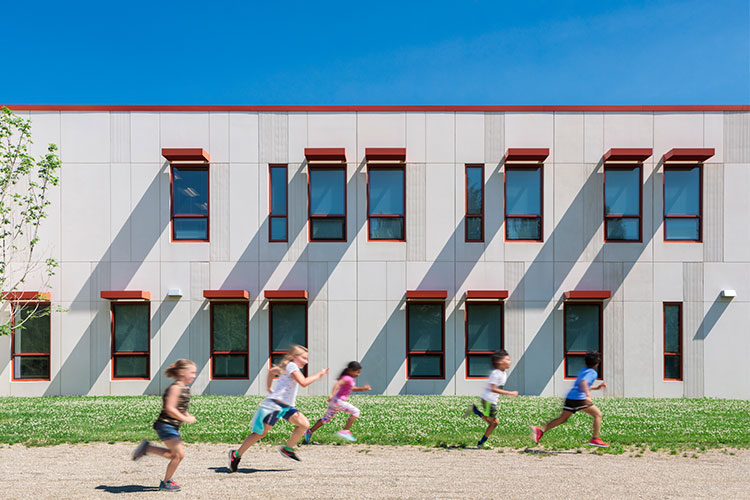
Caps were provided at exposed ends matching the exterior finish with steel plates and studs welded to the interior panels allowing for easy anchorage to the building’s primary structure. Thicker panels and an attention to detail in avoiding tight and mitered corners mitigated the potential for chipping. This direction in design led to a flexible panelized solution which met the aesthetic and sustainable needs for the project simultaneously, resulting in LEED Silver certification.
Revealing Concrete's Inner Beauty
When casting in place, there are generally three ways to achieve compelling architecturally exposed concrete aesthetics.
- Brushing/washing is the oldest method and the easiest because no chemical retarders are involved. The thin layer of surface mortar covering the aggregate is simply washed away by spraying water and scrubbing the surface with a broom to the desired depth. Timing is critical for this approach, so it is typically used for smaller jobs where there is more control over the final product.
- A surface retarder can also be used immediately after placing and finishing. This application delays setting and allows for flexibility in removing cement paste 24 to 48 hours after placement. Scrubbing and pressure washing are two effective means to remove the paste. This application is typically used for larger projects with summer-long project schedules.
- Finally, abrasive blasting is most often achieved by sandblasting or shot blasting. The primary disadvantage to this approach is that it can fracture aggregate and dull the surface quality of the concrete. This approach should be avoided, if possible, when the best possible aesthetic for a concrete wall is desired.
Other Options
In addition to pouring and exposure methods, other ways to alter the appearance of architecturally exposed concrete include the following:
- Use contrasting aggregate (sizes, textures)
- Color the concrete in a shade that complements the aggregate
- Use chemical stains to highlight patterns
- Place exposed aggregate in bands/fields separated by joints or divider strips
- Vary the degree of aggregate exposure from light to heavy; contrasting different exposure levels next to one another can add a unique effect and highlight certain areas of concrete
Sustainability Considerations
A typical mistake in concrete construction is to add unnecessary prescriptive requirements that may contradict provisions from the American Concrete Institute’s Specifications for Concrete (ACI 301). Limits on supplementary cementitious materials, maximum water to cementitious materials ratios, and grading of aggregates can severely impact the carbon footprints inherent in concrete, regardless of form. Instead, designers and providers should seek to specify performance requirements outlined in ASTM 595 (for blended cements) and ASTM C1157 (for performance cements). These standards will result in concrete construction with Type IL and pozzolan-blended low-alkali cements that reduce the use of natural resources while meeting strength performance targets for the project overall.
Code Considerations
To ensure the best outcome for concrete construction, a design must also consider all structural and code-related implications. The American Concrete Institute (ACI) publishes standards for cover, shrinkage, temperature reinforcement, and typical deflection limitations; for cast-in-place construction, the structural engineer-of-record should be aware that these guidelines are not conservative enough for the demands of exposed concrete. Serviceability issues should also be considered; joints should be placed properly to prevent cracking in undesirable locations. Developed mock-ups and repair details can help control the cost and finish before moving forward with construction. If provided in pre-construction phases, long-term costs can be offset by assuring limited defects will occur in concrete placement.
The ideal convergence of architectural and structural considerations can be found in one document: ACI 303R-12. This reference, provided by the American Concrete Institute, is a guide to cast-in-place concrete that provides helpful tools for understanding the intricacies in finishing concrete. With a thorough understanding, proper reinforcement, time and temperature for placement and crack control can be properly specified. All qualified professionals should address this provision when designing architecturally exposed concrete for commercial construction.
Precast structural walls conversely are required to meet Chapter 14, Section 2 of ASCE 7-16 for loading and serviceability requirements. When architectural finishes are provided for walls, the Precast Concrete Institute offers specifications to achieve desired finishes. Similarly, to achieve the proper finish, it is recommended for non-load bearing precast panels used for cladding to meet the Precast Concrete Institute’s architectural certifications (the PCI has released specifications for 5 levels of surface quality).
Choose Wisely
It should be noted that architecturally exposed concrete is not for every project. Certain processes, such as board-formed concrete, come with a higher premium upfront for the formwork alone. Exposing aggregate can cost up to $2.50 per square foot and decorative touches can roughly add $0.50 per square foot (without considering taxes or fees associated for purchase). Precast panels also have higher upfront costs associated with them and, although versatile, require consistency in exterior wall assembly construction throughout the building perimeter to prove cost effective. Material choice, erection details, and access conditions additionally can impact a cladding budget as well. Yet, while exposed concrete is often costlier at the start of construction, it can provide significant return on investment thanks to the requirements for its design and better durability. It requires lower maintenance, is easily cleaned, and is structurally resilient and aesthetically pleasing. When thoroughly understood, concrete can be elevated from stolid to striking.

Bob Stroup, AIA, WELL AP, CDT, NCARB, LEED AP // Project Architect
With a diverse technical background, Bob has contributed to a vast array of large-scale projects from design through construction. Having worked as an engineer and being a Registered Architect, Bob brings a strong technical skillset and has earned an understanding of what clients and consultants look for from an architect. He excels in product selection, understanding constructibility, implementing sustainable practices and most importantly, working with the client and consultants to deliver the best building possible.
